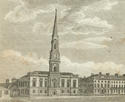 In 1790 the Town Council split up the lands of the Gorbals amongst the Trades House, Hutchesons' Hospital and itself with the intention of encouraging development. Tradeston to the west was feued immediately, followed shortly afterwards by Hutchesontown on St Ninian's croft to the east. Both were feued out on a regular plan by the directors of the hospital on condition that the houses were of a uniform four-storey design. Intended as homes for the well-to-do, access to the city was provided by Hutchesontown Bridge, which was replaced in the early 1830s. In 1801 Hutchesons' Hospital feued part of its ground to James Laurie, a provision merchant, who began to build even grander houses.
In 1790 the Town Council split up the lands of the Gorbals amongst the Trades House, Hutchesons' Hospital and itself with the intention of encouraging development. Tradeston to the west was feued immediately, followed shortly afterwards by Hutchesontown on St Ninian's croft to the east. Both were feued out on a regular plan by the directors of the hospital on condition that the houses were of a uniform four-storey design. Intended as homes for the well-to-do, access to the city was provided by Hutchesontown Bridge, which was replaced in the early 1830s. In 1801 Hutchesons' Hospital feued part of its ground to James Laurie, a provision merchant, who began to build even grander houses.
 Despite the construction of a tramway nearby by William Dixon to link his collieries at Govanhill to the Clyde, development continued. The grand Carlton Place overlooking the river was started in 1802 but not completed until to 1818. No. 52 was Laurie's own house and contains magnificent plasterwork. The enterprise bankrupted him and, with the growth of industry in Tradeston and to the south in Govanhill, the area lost its appeal in favour of Blythswood and the West End.
Despite the construction of a tramway nearby by William Dixon to link his collieries at Govanhill to the Clyde, development continued. The grand Carlton Place overlooking the river was started in 1802 but not completed until to 1818. No. 52 was Laurie's own house and contains magnificent plasterwork. The enterprise bankrupted him and, with the growth of industry in Tradeston and to the south in Govanhill, the area lost its appeal in favour of Blythswood and the West End.
 During comprehensive development of large areas of the city in the 1960s, nearly all the buildings were swept away to make way for high rise flats. Hutchesontown soon earned a reputation for some of the worst designed modern housing in the United Kingdom. Carlton Place was only saved by the determined action of enthusiasts.
During comprehensive development of large areas of the city in the 1960s, nearly all the buildings were swept away to make way for high rise flats. Hutchesontown soon earned a reputation for some of the worst designed modern housing in the United Kingdom. Carlton Place was only saved by the determined action of enthusiasts.